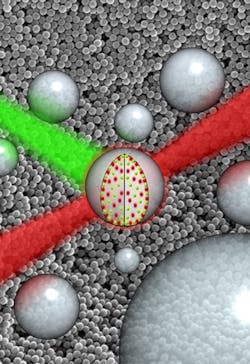New laser material boosts light use in biophotonics
Looking to improve upon the use of light in biophotonics, researchers from the Faculty of Science and Technology at the University of the Basque Country (UPV/EHU) and the Consejo Superior de Investigaciones Científicas (CSIC) and the Universidad Complutense de Madrid have developed a new laser material that incorporates dye moleculesâmaking it more efficient and longer-lasting.
The scientists have obtained efficient, long-lasting emissions of red laser light for the first time, thanks to the incorporation of two dye molecules which are confined in latex nanoparticles dispersed in water. The wavelength of red light is key in photodynamic therapy (PDT), with uses in ophthalmology and dermatology, for example.
Until now, the use of commercial colorants for these applications were limited by the little excitation light they absorbed, an inconvenience which reduced its efficiency. On the other hand, the colorants are normally damaged with ease when excited, reducing its technological use and increases the cost.
To solve these problems, the scientists decided to resort to an energy transfer process known as Förster resonance energy transfer (FRET) based on incorporating two dyes: One donor, capable of efficiently absorbing the excitation and which is hardly damaged, and another acceptor which emits light after having received the energy from the first.
The researchers emphasize that this new laser material eliminates the need to use large volumes of organic solvents, the majority of which are toxic and carcinogenic, avoiding the generation of waste which is harmful to health and the environment.
The development has been published in Nature Photonics; for more information, please visit http://www.nature.com/nphoton/journal/v6/n9/full/nphoton.2012.201.html.
-----
Follow us on Twitter, 'like' us on Facebook, and join our group on LinkedIn
Laser Focus World has gone mobile: Get all of the mobile-friendly options here.
Subscribe now to BioOptics World magazine; it's free!

